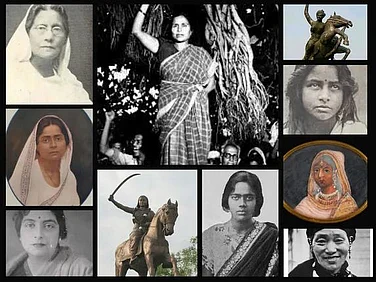The Indian Freedom Struggle was a story of unmatched bravery, sacrifice, and tenacity. Women have played a significant role in the history of independence; they stepped out of their homes, participated in protests, faced arrests, stood in the hardest times, and even suffered brutalities, yet remained undeterred. Their contributions not only fueled the movement but also left an indelible mark on the fight for India's freedom.
The Quit India Movement or भारत छोड़ो आंदोलन, is one of the remarkable incidents in the history of Indian independence and women have played a major role in this epic battle. On August 8, 1942, Mahatma Gandhi delivered his famous “Do or Die” speech at August Kranti Maidan in Bombay (Mumbai). Aruna Asaf Ali, a prominent revolutionary figure, was there hoisting the national flag on the ground, and this led to the official announcement of the Quit India Movement.
Gandhi and other leaders were arrested during the Quit India Movement, which angered people. They took to the streets, destroying railway lines, and police stations were ablaze. Thereafter, women and new leaders emerged as torchbearers of the movement. Unfortunately, the women involved in the movement have suffered a lot; the British brutally tortured them, broke their homes, and subjected women to violence, abuse, and rape. Although hundreds of women took part in the protests, some significant figures stand out in the history of women's involvement in the Quit India Movement.
Indian women who emerged as heroes during the Quit India Movement
Aruna Asaf Ali

Aruna Asaf Ali, also known as the Grand Old Lady, is an iconic revolutionary from Punjab who played a noteworthy role in the Quit India Movement. She was known for raising the Indian flag to support the Quit India Movement. She was also involved in the Salt Satyagraha movement and other notable protests. She first heard the slogan 'Inquilab Zindabad' when her husband Asaf Ali, a Congress leader visited Sardar Bhagat Singh in Lahore Jail as Gandhi's chosen counsel and emissary.
The British government imprisoned her for her engagement in the freedom-fighting movement. Her bravery and disobedience became emblematic of India's quest for independence. She actively participated in many protests, underground operations, and social work, contributing significantly to India's freedom. She also earned the title of heroine of the 1942 movement.
Usha Mehta

A young (22-year-old) activist and law student, Usha Mehta, has become the first radio jockey, the first young lady who is brave enough to establish Congress Radio, an underground radio station that defied British censorship and kept the spirit of resistance alive. Usha played a crucial role in the Quit India Movement of 1942. Her radio station has alerted every Indian about the latest developments in the struggle and has also broadcast patriotic songs such as Vande Mataram. It broadcasts news that has been suppressed by government news agencies. This clandestine operation provided vital information and inspiration to the masses, making her a symbol of courage and determination in the fight for independence. Her contribution to India's freedom is remembered as a testament to the power of the human spirit against oppression.
Matangini Hazra

Matangini Hazra, another staunch Gandhian famously known as the courageous octogenarian, played a significant role in the Indian independence. Her most notable act of defiance occurred during the Quit India Movement, when she led a procession of 6, 000 volunteers, mostly women, to the Tamluk Police Station despite British firing. She was shot three times in her procession and reportedly died with the tricolor in her hands and Vande Mataram on her lips. Her martyrdom sparked revolutionary fever in Bengal, and she is revered as a symbol of steadfast heroism and patriotism.
Kanaklata Barua

In the history of struggle, Kanaklata Barua will always be remembered for her sacrifice. A young Assamese girl who was just 17 was shot and became an iconic martyr during the freedom struggle. She was a part of the famous Quit India Movement and the Mrityu Bahini (death squad). She led a possession, intending to unfurl the national flag, but was shot by the police. She was stopped by the police in charge and she said: “You do your duty and let me do mine”. She has not only bravely confronted the police officer but also become a symbol of unwavering patriotism and courage, inspiring countless others to join the epic struggle for freedom.
Sucheta Kriplani

Sucheta Kriplani, a prominent figure in the history of Independence founded the All India Mahila Congress in 1940. Kriplani was India’s first female chief minister, a key figure in the Quit India Movement, organising underground activities and teaching women to resist. The British arrested her for her involvement in the freedom movement. She was also a professor of constitutional history, exhibiting great leadership and opening the path for future female politicians. On August 15, 1947, she sang "Vande Mataram" in the Constituent Assembly. She is an amazing woman, liberation warrior, and politician in India. Her commitment to the motherland has marked her as one of the movement’s key female fighters.
We can’t even imagine this peace and this freedom without them. We can't ignore how these brave ladies have continuously fought in the hardest times and given their sweat and blood for the motherland. We are all aware of the prominent leader’s contribution to independence. Still, very few of us talk about women and their significant role in the history of independence.
We must not forget the roles of these women and others who are not highlighted in this article; they have contributed and inspired a lot in this freedom struggle. Women not only helped to abolish British rule in India, but they also laid the groundwork for a more inclusive and fair society after independence. Their heroism, resilience, and steadfast dedication to the cause of freedom are still remembered and celebrated as an important part of India's rich history of struggle and triumph.

















